Pattypan Catsclaw Strange Vegetable for Restaurant Menu that can Generate Curiosity
Pattypan,sunchoke/Jerusalemartichoke,Cat’sClaw,Heirloomtomato,salsify or goatsbeard,Samphire or rock samphire are some unique vegetables we discuss in this article.
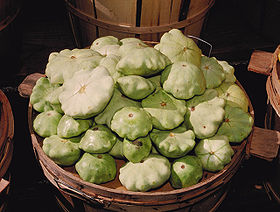 Pattypan comes in yellow, green, and white varieties. The squash is most tender when relatively immature; it is generally served when it is no more than two to three inches in diameter. In fine cuisine, its tender flesh is sometimes scooped out and mixed with flavorings, such as garlic, prior to reinsertion; the scooped-out husk of a pattypan also is sometimes used as a decorative container for other foods. Pattypan is a good source of magnesium, niacin, and vitamins A and C. One cup contains approximately 20 to 30 calories and no fat. It is often sliced, coated and fried until golden brown. In Polish cuisine, they are pickled in sweet vinegar.
Pattypan comes in yellow, green, and white varieties. The squash is most tender when relatively immature; it is generally served when it is no more than two to three inches in diameter. In fine cuisine, its tender flesh is sometimes scooped out and mixed with flavorings, such as garlic, prior to reinsertion; the scooped-out husk of a pattypan also is sometimes used as a decorative container for other foods. Pattypan is a good source of magnesium, niacin, and vitamins A and C. One cup contains approximately 20 to 30 calories and no fat. It is often sliced, coated and fried until golden brown. In Polish cuisine, they are pickled in sweet vinegar.
sunchoke /
Jerusalem artichoke
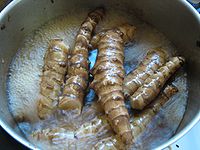 The Jerusalem artichoke (Helianthus tuberosus), also called the sunroot,sunchoke, earth apple or topinambour, is a species of sunflower native to easternNorth America, and found from Eastern Canada and Maine west to North Dakota, and south to northern Florida and Texas. It is also cultivated widely across the temperate zone for its tuber, which is used as a root vegetable.Despite its name, the Jerusalem artichoke has no relation to Jerusalem, and it is not a type of artichoke, even though both are members of the daisy family. The origin of the name is uncertain. Italian settlers in the USA called the plant girasole, the Italian word for sunflower because of its resemblance to the garden sunflower (note: both the sunflower and the sunchoke are part of the same genus: Helianthus). Over time the name girasole may have been changed to Jerusalem.To avoid confusion, some people have recently started to refer to it as sunchoke orsunroot.
The Jerusalem artichoke (Helianthus tuberosus), also called the sunroot,sunchoke, earth apple or topinambour, is a species of sunflower native to easternNorth America, and found from Eastern Canada and Maine west to North Dakota, and south to northern Florida and Texas. It is also cultivated widely across the temperate zone for its tuber, which is used as a root vegetable.Despite its name, the Jerusalem artichoke has no relation to Jerusalem, and it is not a type of artichoke, even though both are members of the daisy family. The origin of the name is uncertain. Italian settlers in the USA called the plant girasole, the Italian word for sunflower because of its resemblance to the garden sunflower (note: both the sunflower and the sunchoke are part of the same genus: Helianthus). Over time the name girasole may have been changed to Jerusalem.To avoid confusion, some people have recently started to refer to it as sunchoke orsunroot.
 Uncaria tomentosa (popularly known in English as Cat’s Claw, although that name is also used for various other plants; in Spanish as Uña de Gato (Cat’s Claw) or as Indian name Vilcacora) is a woody vine found in the tropical jungles of South and Central America, which derives its name from its claw-shaped thorns. It is used as an alternative medicine in the treatment of a variety of ailments. Other common names include: hawk’s claw, pot hook, and sparrowhawk nail
Uncaria tomentosa (popularly known in English as Cat’s Claw, although that name is also used for various other plants; in Spanish as Uña de Gato (Cat’s Claw) or as Indian name Vilcacora) is a woody vine found in the tropical jungles of South and Central America, which derives its name from its claw-shaped thorns. It is used as an alternative medicine in the treatment of a variety of ailments. Other common names include: hawk’s claw, pot hook, and sparrowhawk nail
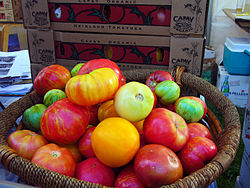 An heirloom tomato (also called heritage tomato in the UK) is an open-pollinated (non-hybrid) heirloom cultivar of tomato. Heirloom tomatoes have become increasingly popular and more readily available in recent years. They are grown for historical interest, access to wider varieties, and by people who wish to save seeds from year to year.
An heirloom tomato (also called heritage tomato in the UK) is an open-pollinated (non-hybrid) heirloom cultivar of tomato. Heirloom tomatoes have become increasingly popular and more readily available in recent years. They are grown for historical interest, access to wider varieties, and by people who wish to save seeds from year to year.
There are two species – Tragopogon porrifolius – Scorzonera hispanica is a genus of flowering plants in the sunflower family Asteraceae that has over 140 species, including the vegetableknown as salsify, as well as a number of common wild flowers, some of which are usually regarded as weeds.
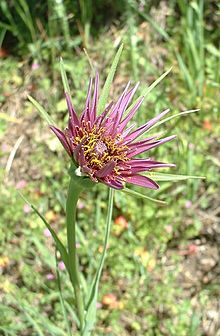 Salsifies are forbs growing as biennial or perennial plants. They have a strong taproot and milky sap. They generally have few branches, and those there are tend to be upright. Their leaves are somewhat grass-like. Flower colour varies within the genus, with some yellow species, and some bronze or purple. Seeds are borne in a globe like that of a dandelion but larger, and are dispersed by the wind
Salsifies are forbs growing as biennial or perennial plants. They have a strong taproot and milky sap. They generally have few branches, and those there are tend to be upright. Their leaves are somewhat grass-like. Flower colour varies within the genus, with some yellow species, and some bronze or purple. Seeds are borne in a globe like that of a dandelion but larger, and are dispersed by the wind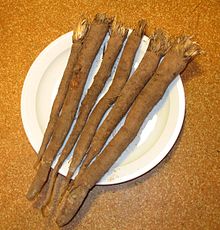 Tragopogon porrifolius is a plant cultivated for its ornamental flower, edible root, and herbal properties. It also grows wild in many places and is one of the most widely known species of the salsify genus, Tragopogon. It is commonly known as purple or common salsify, oyster plant, vegetable oyster, Jerusalem star,goatsbeard or simply salsify (although these last two names are also applied to other species, as well).
Tragopogon porrifolius is a plant cultivated for its ornamental flower, edible root, and herbal properties. It also grows wild in many places and is one of the most widely known species of the salsify genus, Tragopogon. It is commonly known as purple or common salsify, oyster plant, vegetable oyster, Jerusalem star,goatsbeard or simply salsify (although these last two names are also applied to other species, as well).
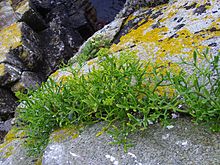 Samphire or rock samphire, Crithmum maritimum, is the sole species of the genus Crithmum. It is an edible wild plant found on southern and western coasts of Britain and Ireland, on mediterranean and western coasts of Europe including the Canary Islands, North Africa and the BlackSea. The term samphire is used for several unrelated species of coastal plant.Rock samphire has fleshy, divided aromatic leaves that Culpeper described as having a “pleasant, hot and spicy taste”
Samphire or rock samphire, Crithmum maritimum, is the sole species of the genus Crithmum. It is an edible wild plant found on southern and western coasts of Britain and Ireland, on mediterranean and western coasts of Europe including the Canary Islands, North Africa and the BlackSea. The term samphire is used for several unrelated species of coastal plant.Rock samphire has fleshy, divided aromatic leaves that Culpeper described as having a “pleasant, hot and spicy taste”The stems, leaves and seed pods may be pickled in hot, salted, spiced vinegar, or the leaves used fresh in salads.
Image and source courtesy wikepedia
